While spectacles have increasingly be a style statement, these humble companions would be the one object that many of us count on during the day for any erogenous need. There are today various kinds of frames and fashoins which is perhaps why we have a tendency to look through the value of lenses – the main element component that makes spectacles what they’re.
The convex lenses were the initial ones to make for stopping far-sightedness after which came the concave lenses to take care of short-sightedness. A good deal retreats into regarding lenses. Knowing more about how lenses are produced may help eyewear users appreciate the basic steps associated with selecting the most appropriate spectacles. As an illustration, did you know that it is very important choose your frames as outlined by your prescription? For the reason that, lenses are cut in accordance with the frames and certain prescriptions may well not fit small or thick frames. You are able to understand why and much more when you read on to learn the way your prescription lenses have been made.
Garbage
Before, opticians depended on separate optical laboratories to make lenses. But now, full-service outlets that produce lenses for clients with the same place would be the norm. These outlets get plastic pieces that happen to be injection moulded and appearance like hockey pucks.
The manufacturing procedure for lenses involves several steps.
Surfacing and blocking
The laboratory technician inputs the optical prescription data in the computer and it provides a listing of the information necessary for producing the necessary prescription lenses. The following critical step is the place the technician marks the precise position of one’s pupils if you are wearing the glasses (not yet fitted with the corrected lenses). This is when a lensometer is used with the technician – to find the career.

Next, a lens lathe is used. A lathe is any mechanical device utilized to slice an object symmetrically. The lathe trims the lens from behind to obtain the desired thickness and precision.
Polishing
When it’s just from the lathe, the rear of the lens is a bit rough. So the technician places the lens in the fining machine referred to as a lap, which polishes it. First, each lens is rubbed against a tough fining pad manufactured from soft sandpaper. Then your laps are taken from each lens and soaked in hot water for a couple minutes. Next these are attached time for the lenses and placed in the fining machine for polishing. The equipment then rotates the fining pad inside a circular motion while a polishing compound operates in the lenses.
Edging
After polishing, the lens is much thinner than if it begins. Nevertheless it still has to be decrease to a smaller size. The lens is currently put into a lens edger with the frame selected for this. The edger utilizes a digital tracer to capture the three-dimensional image of the frame by utilizing a diamond cutting wheel, cuts the lens to the precise measurements given by the optician.
Coating
This can be the final process when the lenses are dipped right into a tint container being coated. Coating makes lenses proof against scratching, anti-reflective or capable to block UV rays. The lens usually receives around 16 ultrathin layers of metal oxide coatings. After drying, the lens is preparing to be inserted to the desired frames.
During the whole production process these spectacle lenses undergo four basic inspections – three ones happening in the laboratory and also the fourth one in the optical outlet. They include examining the optical prescription, verifying the optical centre placement, verifying the frame alignment and visually looking for scratches.
For additional information about LMU Rebuild Service browse this popular website.
